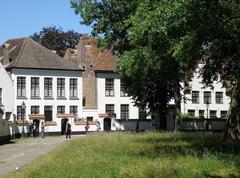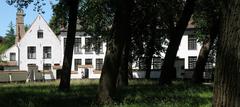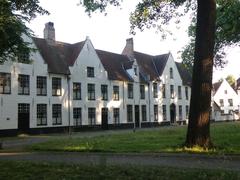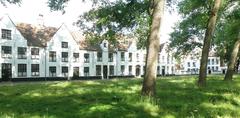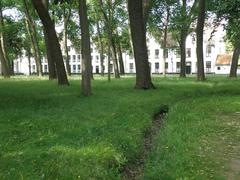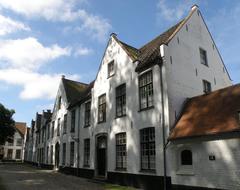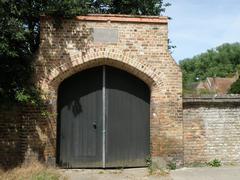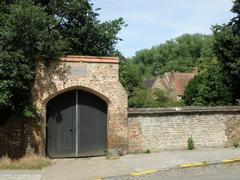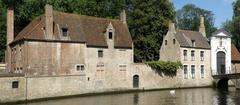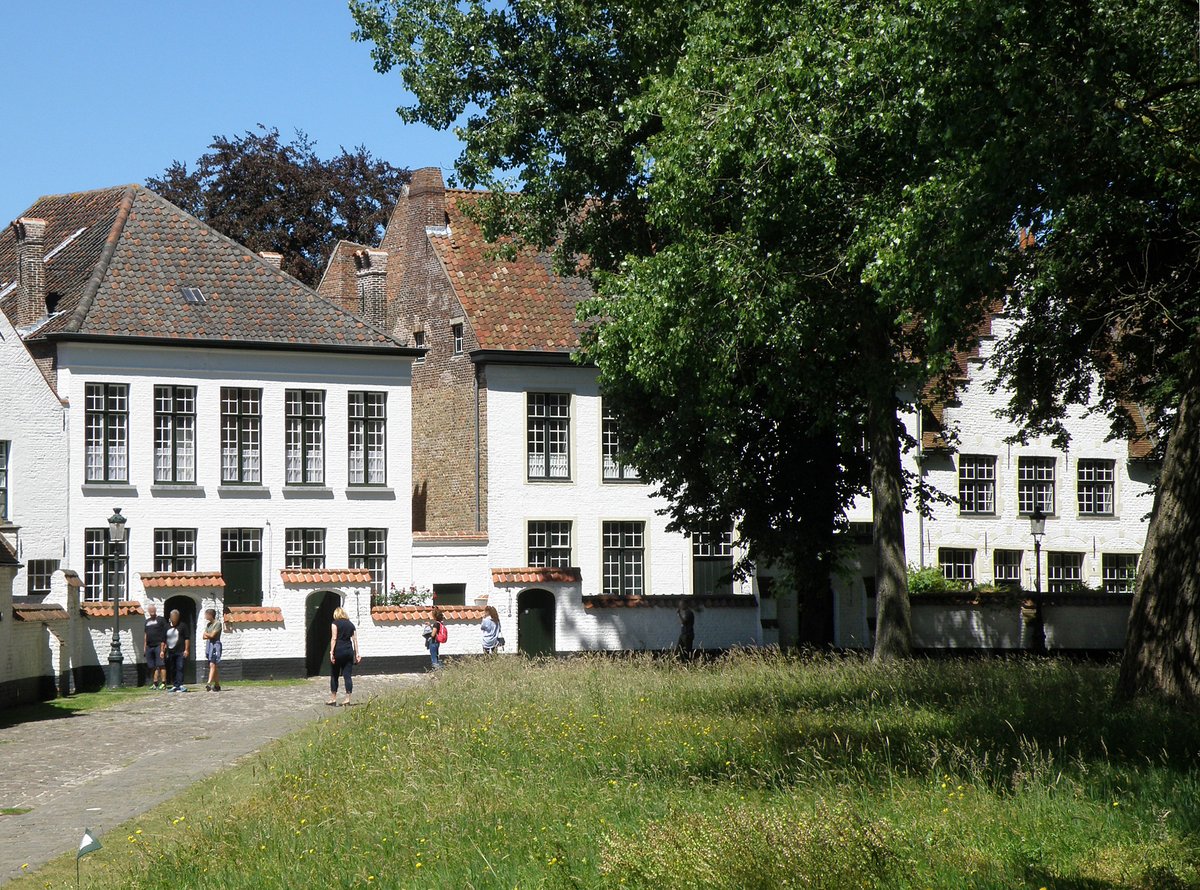
Ten Wijngaerde Beguinage Bruges: Visiting Hours, Tickets, and Historical Sites Guide
Date: 14/06/2025
Introduction
Nestled in the heart of Bruges, Belgium, the Princely Beguinage Ten Wijngaerde stands as a serene and well-preserved testament to medieval religious life, women’s autonomy, and Flemish heritage. Founded in 1245 under the patronage of Margaret of Constantinople, this beguinage was home to the beguines—lay religious women who created a unique community, balancing spiritual devotion, charity, and economic independence, notably through crafts like lace-making (Bruges Beguinage Official Site; Afar). Today, Ten Wijngaerde is recognized as a UNESCO World Heritage Site, celebrated for its tranquil beauty and rich history.
This comprehensive guide covers everything you need to plan your visit: history, architecture, visiting hours, ticketing, accessibility, tips, and insights into the beguinage’s ongoing cultural significance.
Contents
- Early Origins and Foundation
- Medieval Development and Royal Patronage
- Architectural Evolution
- Social and Religious Life
- Transition to Benedictine Convent
- Visiting Information: Hours, Tickets, and Accessibility
- Tips for Visitors
- Heritage and UNESCO Recognition
- Frequently Asked Questions (FAQ)
- Conclusion and Call to Action
Early Origins and Foundation
Ten Wijngaerde’s origins date to the early 13th century, as religious women called beguines settled on the “de Wingarde” domain—likely named for its meadows rather than actual vineyards (Bruges Beguinage Official Site). With support from Margaret of Constantinople and ecclesiastical approval in 1244, the beguinage was established as an independent parish by 1245 (UNESCO World Heritage Centre). This organizational autonomy allowed the beguines to structure their daily life and worship outside of traditional monastic rules.
Medieval Development and Royal Patronage
The beguinage thrived in 13th and 14th-century Bruges, benefiting from the city’s prosperity and vibrant urban life. In 1299, King Philip the Fair of France placed it under royal authority, granting it “Princely” status and securing its protection and privileges (Flemish Heritage Agency). This support enabled the beguinage to grow into a self-sufficient community, complete with its own church, infirmary, bakery, and communal spaces.
Architectural Evolution
Ten Wijngaerde’s architecture reflects centuries of adaptation. The complex is characterized by about thirty white-painted houses arranged around a peaceful central courtyard, a Gothic church, and a striking entrance via the three-arched stone Wijngaard Bridge. The entrance gate, added in 1776 by mason Hendrik Bultynck, features a statue of Saint Elizabeth of Hungary (Visit Bruges; Spotting History). Most residential buildings date from the 16th to 18th centuries, unified by their gabled roofs and simple, elegant Flemish style. The church, originally Gothic, has Baroque interior touches and serves as the spiritual heart of the site (Belgium Travel).
Social and Religious Life
Beguines lived a distinctive communal life, balancing religious devotion with personal independence. Unlike nuns, they did not take permanent vows, enabling them to leave and re-enter the community as circumstances required. Their daily routine included prayer, charitable work, and economic activity—especially lace-making and textiles, which became synonymous with Bruges craftsmanship (Amazing Belgium). Governed by an elected mistress, the beguinage provided a haven for single and widowed women.
Transition to Benedictine Convent
By the early 20th century, the beguine movement had waned. In 1927, after the departure of the last beguine, the site was transformed into a Benedictine convent known as the Monasterium De Wijngaard, preserving its religious function and allowing public access to parts of the complex, including a museum showcasing beguine life (Bruges Beguinage Official Site).
Visiting Information: Hours, Tickets, and Accessibility
Opening Hours:
- Courtyard and Gardens: 6:30 AM – 6:30 PM
- Church: 9:00 AM – 6:30 PM
- Museum: 10:00 AM – 5:00 PM
Admission:
- Courtyard and Church: Free
- Museum: €2–€3 per adult (discounts for students, seniors, children)
- Guided tours available via local agencies and the Bruges tourist office (advance booking recommended)
Accessibility:
- Main paths are flat and accessible for wheelchairs and strollers; some buildings have steps or narrow entrances
- Restrooms and seating available near the entrance
Photography:
- Allowed in outdoor areas; generally prohibited inside the church and museum
Tips for Visitors
- Best Time to Visit: Early morning or late afternoon, especially outside weekends and holidays, for a quieter experience
- Dress Modestly: Particularly in the church
- Silence: Maintain a quiet atmosphere out of respect for residents
- No Picnics or Pets: Only service animals allowed
- Combine Sites: Pair your visit with nearby Minnewaterpark or the Church of Our Lady
Heritage and UNESCO Recognition
Ten Wijngaerde is the only preserved beguinage in Bruges and one of the best in Flanders. In 1998, it was inscribed on the UNESCO World Heritage List, recognized for its unique role in women’s history, urban development, and medieval society (UNESCO World Heritage Centre). The site remains inhabited by Benedictine nuns and single women, maintaining a tradition of contemplative communal life.
Frequently Asked Questions (FAQ)
Q: What are the visiting hours?
A: Courtyard and gardens: 6:30 AM–6:30 PM; Church: 9:00 AM–6:30 PM; Museum: 10:00 AM–5:00 PM.
Q: Is there an admission fee?
A: Entry to the courtyard and church is free; museum admission is €2–€3.
Q: Are guided tours available?
A: Yes, they can be booked through local agencies or the tourism office.
Q: Is Ten Wijngaerde accessible for wheelchairs?
A: Main paths are accessible, but some buildings have steps; contact ahead for details.
Q: Can I take photos inside?
A: Photography is welcome outdoors, but not inside the church or museum.
Conclusion and Call to Action
The Princely Beguinage Ten Wijngaerde offers a rare window into Bruges’ medieval past and the pioneering spirit of its beguines. Whether exploring its whitewashed courtyards, learning about its social history, or simply enjoying its tranquil atmosphere, a visit to Ten Wijngaerde is a highlight of any Bruges itinerary.
For detailed updates, event information, and audio tours, check the official Beguinage website and consider downloading the Audiala app.
Plan your visit today, and immerse yourself in the unique heritage of Bruges’ most peaceful and historic enclave.
References
- Bruges Beguinage Official Site
- Visit Bruges - Ten Wijngaerde
- Afar - At Beguinages in Belgium: Finding History, Feminism, and Freedom
- Full Suitcase - Bruges Things to Do
- Flemish Heritage Agency
- UNESCO World Heritage Centre
- Spotting History - Bruges Beguinage
- Belgium Travel - Beguinage in Bruges
